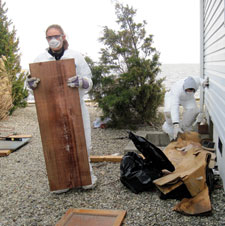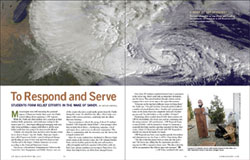To Respond and Serve
Students form relief efforts in the wake of Sandy.
Meteorologists were still forecasting the potential impact of Hurricane Sandy when senior Izzy Parilis started talking about organizing a GW response.
While Ms. Parilis and other students were cooped up in their residence halls, apartments, and townhouses waiting for the storm to pass D.C., they began talking and messaging with each other about mobilizing a campus relief effort to aid the areas farther north that were going to be more severely affected.
"I think a lot of people were moved to serve because it had hit so close to home," says Ms. Parilis. Hurricane Sandy—later called Superstorm Sandy—caused widespread damage and flooding in areas of New York and New Jersey in late October and is the largest Atlantic hurricane on record, according to the National Hurricane Center.
Tim Savoy, a Presidential Administrative Fellow in the Center for Civic Engagement and Public Service, was one of the people who saw a social media update from Ms. Parilis during the storm. He asked how his office, which helps coordinate GW's service activities, could help with the efforts that were brewing.

A group of 14 students and one staff member traveled to Toms River, N.J., after Superstorm Sandy to help repair damaged houses.
Courtesy Center for Civic Engagement and Public Service
Upon returning to school, the group of about 20 students founded "GW Responds: Sandy Relief," a four-pronged effort that includes blood drives, a fundraising campaign, a food and supply drive, and service in affected communities. The effort is a partnership with the university, says Mr. Savoy, but is largely student led.
Since the storm, students have fundraised at Election Night watch parties at the Marvin Center, the GW Alumni Holiday Party, and the holiday party for faculty and staff members; collected supplies and food; organized a blood drive with the Red Cross; and put together a service trip to Toms River, N.J., where they helped clean out debris from damaged homes.
More than 250 students completed interest forms to participate in the service trip, which could only accommodate 14 students, says Mr. Savoy. They picked students through a lottery and are hoping to have more service trips to the region this semester.
"Everyone on the trip had a different reason for being there," Ms. Parilis says. "One girl was from Venezuela and had suffered a number of natural disasters there. Another girl's grandparents' home on the Jersey Shore was completely destroyed. Another guy just said, 'I'm able-bodied, so why wouldn't I be here?'"
Fundraising efforts totaled about $5,000 when students left GW for the holidays, Mr. Savoy says, and are continuing into the spring semester. All contributions—GW Responds hopes to raise $25,000—will be donated to Adopt-A-Classroom, a nonprofit that helps teachers purchase materials for their classrooms. Adopt-A-Classroom will work with GW Responds to identify the schools hit hardest by Sandy.
GW Responds may have come together quickly, but students and administrators say they hope it will be a long-lasting effort.
"The idea is that this project won't go away once the goal is met," Mr. Savoy says, adding that the organization provides a structure for GW to respond to future crises. "The idea is that this will be an organization that delivers large-scale responses."
—GW Today contributed to this report.
Want to get involved?
For more information on how alumni and friends of the university can contribute to GW Responds, visit serve.gwu.edu/gw-responds.

